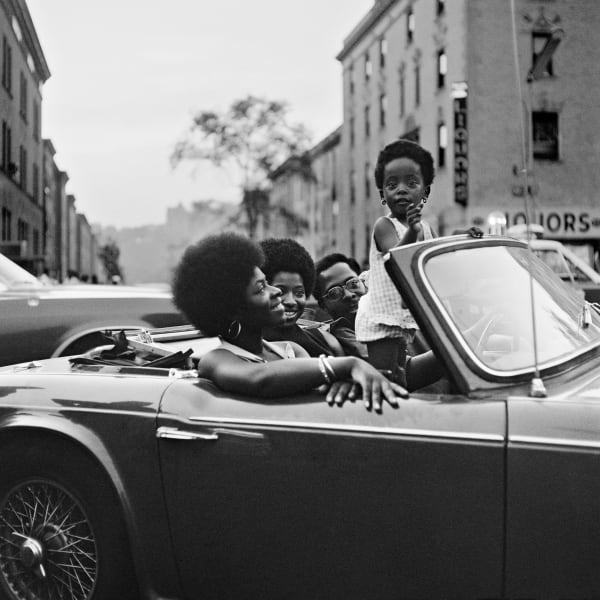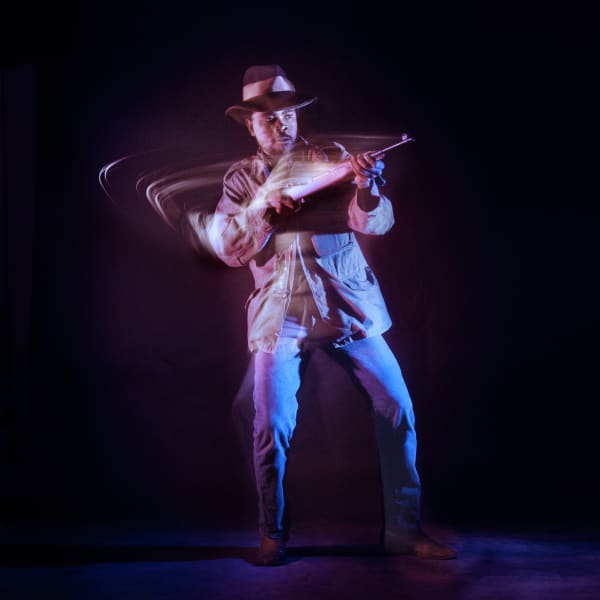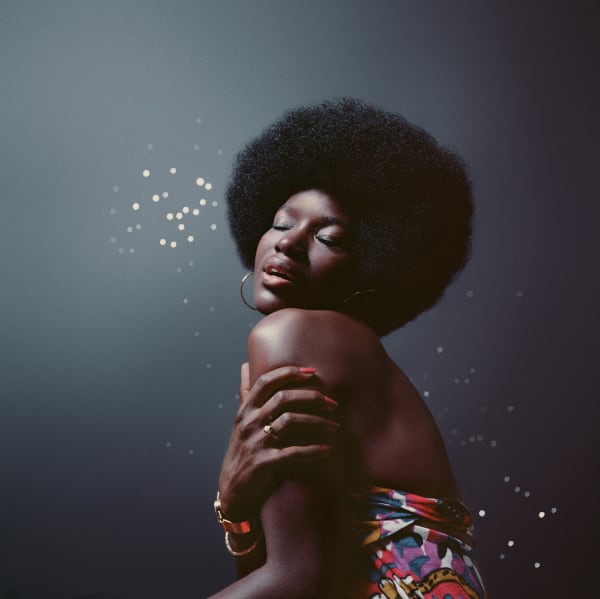-
" There was a clear connection between the role of influence and celebrity on society, and how things were taking place in society. There was the active role of the celebrity that [my father] followed in his work, and people whom he became friends with and photographed. They held the core values of the 'Black is Beautiful' movement. But there was also this notion of the 'everyday' person that carried those values, and how they became influencers and people who had an impact on society and life within the Diaspora.” –Kwame S. Brathwaite
-

-
Shot between 1965-1975, Brathwaite's thoughtful, strikingly beautiful images depict love and unity across the Black diaspora. In photographs exploring Black subjectivity and viewership, Brathwaite, a leading architect of "Black is Beautiful," demonstrates that the power to construct one's own image is a vital tool for freedom, dignity, and self-determination.
-

-
Historian Dr. Peniel Joseph recently pointed out that Kwame Brathwaite and Elombe Brath, alongside icons like Malcolm X, Abbey Lincoln and Max Roach, "built a Black radical moment" in early 60s New York. Their work was part of an intellectual and artistic ferment that not only connected to the Harlem Renaissance, but also was an incredibly important forerunner to the Black Arts Movement.
-

-
A decade later, Kwame Brathwaite was confronting and effecting his own major cultural shifts through the voluminous photography, writing, and ideas he was by then producing: by the late 60s and 70s, Brathwaite’s images were appearing in cultural spaces across the world; the two artist/activist organizations Brathwaite co-founded with his brother Elombe Brath - African Jazz Arts Society and Studios (AJASS) and Grandassa Models - were firmly established; collaborations with friends like Muhammad Ali, Nina Simone, Bob Marley and Miles Davis had made Brathwaite one of the top concert photographers in world; Brathwaite regularly appeared in the "New York Beat" section of Jet magazine; 1974, his wife and muse, Sikolo Brathwaite, gazed out from the cover of Essence, radiant, pregnant with their son, Kwame S. Brathwaite, who was born that same year.
-

-
The works in Philip Martin Gallery’s exhibition, "Changing Times" find Brathwaite in a moment of expanding vision, meditating on the "Black is Beautiful" movement he worked so hard to establish, thinking about Black joy, Black excellence and the beauty of the Black body he loved so much. One photograph, "Untitled (Crowd at Human Kindness Day)," presents a dense visual scene in which the various subjects of the photograph interact, their gazes falling on one another. Brathwaite, in typical form, inserts the viewer squarely into the moment, eye-to-eye with the crowd. Another picture, "Untitled (Grandassas in Car)," presents Sikolo Brathwaite, Jaunita McClean and daughter Tiffany McClean at the 1968 Garvey Day parade in New York. The viewer is engaged not only through the love and emotion of the scene, but also by the look the child, who looks directly at the camera.
-

-
"Untitled (Abbey Lincoln and Dancer)," presents AJASS founding member Abbey Lincoln and a beautiful young man - likely from Dinizulu dance company - in a moment of call and response. It is an extraordinary shot, indicative of Brathwaite’s way of working. As professor Peniel Joseph notes, “in finding beauty in the Black quotidian," Brathwaite is "spotlighting Malcolm X's idea of radical Black dignity.” As such, Brathwaite’s image-making practice finds resonance in our discourse around image today, providing an important conceptual framework for thinking about how images are constructed and read in both mass- and social media.
-

-
In a 2019 panel discussion on Kwame Brathwaite's work, Tyler Mitchell made an important point, stating that in creating an archive of images Brathwaite, "shows us that documenting and reimagining Blackness as a whole in your community is actually very important, and that to convey Black beauty is actually an act of justice.” Kwame Brathwaite's photographs recognize the power of image, and just as importantly, the power of people. His subjects are actual individuals with their own agency and stories to tell.
-

-
Several of the works included in "Changing Times" take on the power of connection in day-to-day life. "Untitled (Hands in the Shape of a Unity Symbol)” presents arms embracing in the unity symbol. A rare multi-part work, "Untitled (Dap),” provides Brathwaite - a man who cut his teeth photographing dance, boxing, music and performance - a chance to investigate the expressive physical flow of the Dap (“dignity and pride”), a gestural language now common in American culture, which had originated by necessity in shared statements of solidarity and survival between Black G.I.s in Vietnam.
-

-
Another shot, "Revolutionary Movement" is one of the few moments in which Brathwaite depicts weapons. Brathwaite actively supported liberation movements around the world through funds and social action, co-founding a P.L.A.N. (People's Liberation Army of Namibia) support group in 1962. However, like many Black intellectuals of the time, Brathwaite's perspective was much more nuanced than our current cultural discourse allows; in his work, a revolutionary holding a weapon is a visually striking and powerful double entendre on "revolutionary movement,” and a comment perhaps on Brathwaite's part that things are not always what they seem. A leading Pan-Africanist, throughout the 60s and 70s Kwame Brathwaite was in touch with a range of African leaders. Brathwaite first met future Namibian president Sam Nujoma in 1961, and had an on-going relationship with Guniean leader Ahmed Sékou Touré. In 1975, for example, AJASS's publishing arm, Black Standard Publishing Company, published an English translation of a famous Touré speech accompanied with Brathwaite's own images.
-

-
One of the images included in "Changing Times," "Untitled (Independence Day)," depicts a celebratory moment in the new African nation. As photographer David Hartt noted, comparing in a sense Brathwaite's vision with that of Ghanaian photographer James Barnor, "The conventions of center and periphery were being radically redefined" by artists like Barnor and Brathwaite, who in their work negotiated their "own positionality as witness and participant, a subtle force shaping the dimensions of Black representation.”
-

-
The exhibition also includes several examples of Brathwaite’s on-going interest in the possibilities of studio portraiture. Two photographs, "Untitled (Couple's Embrace)" and "Untitled (Couple's Gaze)," feature a wonderful moment of connection and intimacy. Other works, such as "Untitled (Portrait, Reels as Necklace)" and "Untitled (Portrait, Reels as Crown)" re-think the classical portrait heads of the late 60s for which Brathwaite had become widely known; in this case, with the camera reels used to refer to the practice of photography itself and Brathwaite’s deep thinking on the process of representing Black subjectivity.
-

-
In "Changing Times," we see ecstasy in dance and performance, the beauty of the Black body in the round, a feeling of protest and participation, love and connection, and a range of staged narratives in the studio touching on revolution, liberation and a conceptual depiction of Black strength and fellowship. Classical in his vision, contemporary in his practice, Kwame Brathwaite structures these works with an eye to putting the viewer into the scene - visually, metaphorically - to stand where he stands, see what he sees, feel what he feels.
-

-
Brathwaite was always photographing. Whether doing so in his Harlem studio, on the streets of New York, or around the world, Brathwaite's dedication to revealing, documenting and enjoying Black life is always at the forefront; in the works included in “Changing Times,” Brathwaite is becoming, as he would later be known, as "the keeper of the images."
-
Works by Kwame Brathwaite
Click image to inquire-
 Kwame Brathwaite, Untitled (Hands in the Shape of a Unity Symbol), 1971 c.
Kwame Brathwaite, Untitled (Hands in the Shape of a Unity Symbol), 1971 c. -
 Kwame Brathwaite, Untitled (Dap), 1970 c., printed 2021
Kwame Brathwaite, Untitled (Dap), 1970 c., printed 2021 -
 Kwame Brathwaite, Untitled (Abbey Lincoln and Dancer), 1965 c.
Kwame Brathwaite, Untitled (Abbey Lincoln and Dancer), 1965 c. -
 Kwame Brathwaite, Untitled (Grandassas in Car), 1968 c.
Kwame Brathwaite, Untitled (Grandassas in Car), 1968 c. -
 Kwame Brathwaite, Untitled (Pearls), 1970 c., printed 2021
Kwame Brathwaite, Untitled (Pearls), 1970 c., printed 2021 -
 Kwame Brathwaite, Untitled (Couple's Embrace), 1971 c., printed 2021
Kwame Brathwaite, Untitled (Couple's Embrace), 1971 c., printed 2021 -
 Kwame Brathwaite, Revolutionary Movement, 1972 c., printed 2021
Kwame Brathwaite, Revolutionary Movement, 1972 c., printed 2021 -
 Kwame Brathwaite, Untitled (Crowd at Human Kindness Day), 1975 c., printed 2021
Kwame Brathwaite, Untitled (Crowd at Human Kindness Day), 1975 c., printed 2021 -
 Kwame Brathwaite, Untitled (Independence Day), 1973 c.
Kwame Brathwaite, Untitled (Independence Day), 1973 c. -
 Kwame Brathwaite, Changing Times, 1973 c.
Kwame Brathwaite, Changing Times, 1973 c. -
 Kwame Brathwaite, Untitled (Portrait, Reels as Necklace), 1972 c., printed 2021
Kwame Brathwaite, Untitled (Portrait, Reels as Necklace), 1972 c., printed 2021 -
 Kwame Brathwaite, Untitled (Portrait, Reels as Crown), 1972 c., printed 2021
Kwame Brathwaite, Untitled (Portrait, Reels as Crown), 1972 c., printed 2021
-
-
Press Release
Philip Martin Gallery is proud to present, "Changing Times," an exhibition of never-before-seen works by photographer Kwame Brathwaite (b. 1938, Brooklyn, NY). Shot between 1965-1975, Brathwaite's thoughtful, strikingly beautiful images depict love and unity across the Black diaspora. In photographs exploring Black subjectivity and viewership, Brathwaite, a leading architect of "Black is Beautiful," demonstrates that the power to construct one's own image is a vital tool for freedom, dignity, and self-determination.
Historian Dr. Peniel Joseph recently pointed out that Kwame Brathwaite and Elombe Brath, alongside icons like Malcolm X, Abbey Lincoln and Max Roach, "built a Black radical moment" in early 60s New York. Their work was part of an intellectual and artistic ferment that not only connected to the Harlem Renaissance, but also was an incredibly important forerunner to the Black Arts Movement. A decade later, Kwame Brathwaite was confronting and affecting his own major cultural shifts through the voluminous photography, writing, and ideas he was by then producing: by the late 60s and 70s, Brathwaite’s images were appearing in cultural spaces across the world; the two artist/activist organizations Brathwaite co-founded with his brother Elombe Brath - African Jazz Arts Society and Studios (AJASS) and Grandassa Models - were firmly established; collaborations with friends like Muhammad Ali, Nina Simone, Bob Marley and Miles Davis had made Brathwaite one of the top concert photographers in world; Brathwaite regularly appeared in the "New York Beat" section of Jet magazine; 1974, his wife and muse, Sikolo Brathwaite, gazed out from the cover of Essence, radiant, pregnant with their son, Kwame S. Brathwaite, who was born that same year.
The works in Philip Martin Gallery’s exhibition, "Changing Times" find Brathwaite in a moment of expanding vision, meditating on the "Black is Beautiful" movement he worked so hard to establish, thinking about Black joy, Black excellence and the beauty of the Black body he loved so much. One photograph, "Untitled (Crowd at Human Kindness Day)," presents a dense visual scene in which the various subjects of the photograph interact, their gazes falling on one another. Brathwaite, in typical form, inserts the viewer squarely into the moment, eye-to-eye with the crowd. Another picture, "Untitled (Grandassas in Car)," presents Sikolo Brathwaite, Jaunita McClean and daughter Tiffany McClean at the 1968 Garvey Day parade in New York. The viewer is engaged not only through the love and emotion of the scene, but also by the look the child, who looks directly at the camera.
"Untitled (Abbey Lincoln and Dancer)," presents AJASS founding member Abbey Lincoln and a beautiful young man - likely from Dinizulu dance company - in a moment of call and response. It is an extraordinary shot, indicative of Brathwaite’s way of working. As professor Peniel Joseph notes, “in finding beauty in the Black quotidian," Brathwaite is "spotlighting Malcolm X's idea of radical Black dignity.” As such, Brathwaite’s image-making practice finds resonance in our discourse around image today, providing an important conceptual framework for thinking about how images are constructed and read in both mass- and social media. In a 2019 panel discussion on Kwame Brathwaite's work, Tyler Mitchell made an important point, stating that in creating an archive of images Brathwaite, "shows us that documenting and reimagining Blackness as a whole in your community is actually very important, and that to convey Black beauty is actually an act of justice.”
Kwame Brathwaite's photographs recognize the power of image, and just as importantly, the power of people. His subjects are actual individuals with their own agency and stories to tell. Philip Martin Gallery’s previous exhibition of Brathwaite’s work, co-curated by actor/activist Jesse Williams and Director of the Brathwaite Archive, Kwame S. Brathwaite, was entitled "Celebrity of the Everyday." In a recent conversation, Kwame S. Brathwaite pointed out that as Brathwaite's peers in Grandassa Model and AJASS became known, "There was a clear connection between the role of influence and celebrity on society, and how things were taking place in society. There was the active role of the celebrity that [my father] followed in his work, and people whom he became friends with and photographed. They held the core values of the 'Black is Beautiful' movement. But there was also this notion of the 'everyday' person that carried those values, and how they became influencers and people who had an impact on society and life within the Diaspora.”
Several of the works included in "Changing Times" take on the power of connection in day-to-day life. "Untitled (Hands in the Shape of a Unity Symbol)” presents arms embracing in the unity symbol. A rare multi-part work, "Untitled (Dap),” provides Brathwaite - a man who cut his teeth photographing dance, boxing, music and performance - a chance to investigate the expressive physical flow of the Dap (“dignity and pride”), a gestural language now common in American culture, which had originated by necessity in shared statements of solidarity and survival between Black G.I.s in Vietnam. Another shot, "Untitled (Revolutionary Movement)" is one of the few moments in which Brathwaite depicts weapons. Brathwaite actively supported liberation movements around the world through funds and social action, co-founding a P.L.A.N. (People's Liberation Army of Namibia) support group in 1962. However, like many Black intellectuals of the time, Brathwaite's perspective was much more nuanced than our current cultural discourse allows; in his work, a revolutionary holding a weapon is a visually striking and powerful double entendre on "revolutionary movement,” and a comment perhaps on Brathwaite's part that things are not always what they seem.
A leading Pan-Africanist, throughout the 60s and 70s Kwame Brathwaite was in touch with a range of African leaders. Brathwaite first met future Namibian president Sam Nujoma in 1961, and had an on-going relationship with Guniean leader Ahmed Sékou Touré. In 1975, for example, AJASS's publishing arm, Black Standard Publishing Company, published an English translation of a famous Touré speech accompanied with Brathwaite's own images. One of the images included in "Changing Times," "Untitled (Independence Day)," depicts a celebratory moment in the new African nation. As photographer David Hartt noted, comparing in a sense Brathwaite's vision with that of Ghanaian photographer James Barnor, "The conventions of center and periphery were being radically redefined" by artists like Barnor and Brathwaite, who in their work negotiated their "own positionality as witness and participant, a subtle force shaping the dimensions of Black representation.”
The exhibition also includes several examples of Brathwaite’s on-going interest in the possibilities of studio portraiture. Two photographs, "Untitled (Couple's Embrace)" and "Untitled (Couple's Gaze)," feature a wonderful moment of connection and intimacy. Other works, such as "Untitled (Portrait, Reels as Necklace)" and "Untitled (Portrait, Reels as Crown)" re-think the classical portrait heads of the late 60s for which Brathwaite had become widely known; in this case, with the camera reels used to refer to the practice of photography itself and Brathwaite’s deep thinking on the process of representing Black subjectivity. In "Changing Times," we see ecstasy in dance and performance, the beauty of the Black body in the round, a feeling of protest and participation, love and connection, and a range of staged narratives in the studio touching on revolution, liberation and a conceptual depiction of Black strength and fellowship. Classical in his vision, contemporary in his practice, Kwame Brathwaite structures these works with an eye to putting the viewer into the scene - visually, metaphorically - to stand where he stands, see what he sees, feel what he feels. Brathwaite was always photographing. Whether doing so in his Harlem studio, on the streets of New York, or around the world, Brathwaite's dedication to revealing, documenting and enjoying Black life is always at the forefront; in the works included in “Changing Times,” Brathwaite is becoming, as he would later be known, as "the keeper of the images."
Kwame Brathwaite (b. 1938, New York, NY) is the subject of major touring exhibition, “Kwame Brathwaite: Black Is Beautiful.” The exhibition premiered at the Skirball Cultural Center (Los Angeles, CA), travelled to the Museum of the African Diaspora (San Francisco, CA), Columbia Museum of Art (Columbia, SC) and is currently on view at the Blanton Museum of Art (Austin, TX), and will travel to the Detroit Institute of Art (Detroit, MI); New-York Historical Society (New York, NY), Reynolda House Museum of American Art (Winston-Salem, NC), and additional institutions. A monograph of the same title, produced by the Aperture Foundation, was released May 2019 with essays by Deborah Willis, Professor and Chair of the Department of Photography and Imaging at Tisch School of the Arts of New York University and Tanisha C. Ford, Professor of History at The Graduate Center, CUNY. In 2021, Brathwaite's work was the subject of major in-depth separate acquisitions by the Art Institute of Chicago (Chicago, IL) and National Museum of African American History and Weisman Art Museum (Minneapolis, MN), Culture (Washington, DC). Brathwaite’s work has recently been acquired by such institutions as Santa Barbara Museum of Art (Santa Barbara, CA); Los Angeles County Museum of Art (Los Angeles, CA); Museum of Fine Arts, Houston (Houston, TX); Minneapolis Institute of Art (Minneapolis, MN); Minnesota Museum of American Art (St. Paul, MN); Art Institute of Chicago (Chicago, IL); Block Museum of Art, Northwestern University (Chicago, IL); Pérez Art Museum Miami (Miami, FL); Columbia Museum of Art (Columbia, SC); National Museum of African American History and Culture (Washington, DC); National Portrait Gallery, Smithsonian Institution (Washington, DC); Pennsylvania Academy of the Fine Arts (Philadelphia, PA); Museum of Modern Art (New York, NY); Whitney Museum of American Art (New York, NY); The Frances Young Tang Teaching Museum and Art Gallery at Skidmore College (Saratoga Springs, NY); Museum of the City of New York (New York, NY); The Studio Museum in Harlem (New York, NY); MIT List Visual Arts Center (Cambridge, MA); National Gallery of Canada (Ottawa, ON); and Sharjah Art Museum (Sharjah, United Arab Emirates). Corporate collections include JPMorgan Chase Art Collection (New York, NY) and Sidley Austin LLP (New York, NY). Brathwaite’s work has recently appeared in The New Yorker, The New York Times, Vogue, New York Post, New York Magazine, Aperture, and other publications. Brathwaite lives and works in New York, NY.
Kwame Brathwaite’s exhibition of never-before-seen photographs is on view at the gallery October 2 through November 13, 2021.
Philip Martin Gallery is open Tuesday - Saturday from 10-4 and by appointment. Pre-scheduled appointments are available, and walk-ins are welcome. To make an appointment, or to get additional images, or information please email info@philipmartingallery.com, or call 310-559-0100. Philip Martin Gallery is located at 2712 S. La Cienega Blvd, Los Angeles, CA 90034 in the Culver City area of Los Angeles between Venice Blvd. and Washington Blvd., just south of the 10 Freeway.
-
To inquire about works by Kwame Brathwaite, click here.
Kwame Brathwaite: Changing Times
Past viewing_room























